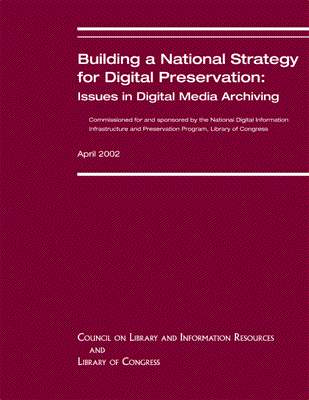Building a National Strategy for Preservation: Issues in Digital Media Archiving

Commissioned for and sponsored by the National Digital Information Infrastructure and Preservation Program, Library of Congress
April 2002
Copublished by the Council on Library and Information Resources and the Library of Congress
Copyright 2002 in compilation by the Council on Library and Information Resources and the Library of Congress. No part of this publication may be reproduced or transcribed in any form without permission of the publishers. Requests for reproduction or other uses or questions pertaining to permissions should be submitted in writing to the Director of Communications at the Council on Library and Information Resources, 1755 Massachusetts Avenue, NW, Suite 500, Washington, DC 20036.
About the National Digital Information Infrastructure and Preservation Program
Summary of Findings, Amy Friedlander
Preserving Digital Periodicals, Dale Flecker
E-Books and the Challenge of Preservation, Frank Romano
Archiving the World Wide Web, Peter Lyman
Preservation of Digitally Recorded Sound, Samuel Brylawski
Understanding the Preservation Challenge of Digital Television, Mary Ide, Dave MacCarn, Thom Shepard, and Leah Weisse
Digital Video Archives: Managing Through Metadata, Howard D. Wactlar and Michael G. Christel
About the National Digital Information Infrastructure and Preservation Program
The mission of the National Digital Information Infrastructure and Preservation Program is to develop a national strategy to collect, archive, and preserve the burgeoning amounts of digital content, especially materials that are created only in digital formats, for current and future generations.
Preface
Libraries traditionally have formed a preservation safety net for materials that will be transmitted to subsequent generations of information seekers and scholars. For paper-based documents, provision of adequate storage conditions was the best means to help ensure that materials would remain readable far into the future.
With the advent of digital technology, many knowledge creators do their work on computers. Some of that knowledge may be printed on paper, but much of it, particularly databases, geographic information, scientific data sets, and Web sites, exists only in electronic form. At the same time, traditional forms of publications have changed significantly and, as a result, create new challenges. For example, publishers of electronic journals license their content to libraries, but libraries do not own that content and they may not have rights to capture digital content to preserve it.
What organizations or systems will provide the needed preservation safety net for electronic materials? Recognizing the importance of this question, the U.S. Congress in December 2000 appropriated funds to the Library of Congress (LC) to spearhead an effort to develop a national strategy for the preservation of digital information. Understanding that the task cannot be accomplished by any one organization, Congress wrote into the appropriations language a requirement that LC work with other federal, scholarly, and nonprofit organizations to discuss the problem and produce a plan.
The staff of the Library of Congress immediately scheduled a series of conversations with representatives from the technology, business, entertainment, academic, legal, archival, and library communities. LC asked the Council on Library and Information Resources to commission background papers for these sessions and to summarize the meetings. The resulting papers, along with an integrative essay by Amy Friedlander, are presented in this document.
The responsibility for preserving digital information will be distributed broadly. Our hope is that information gathered by the Library of Congress will benefit all who are working on this issue.
Deanna Marcum,
President, CLIR
Laura Campbell,
Director, National Digital Library Program
Library of Congress
